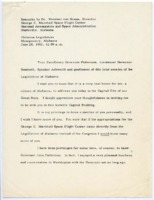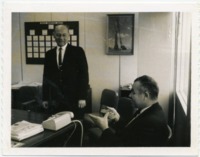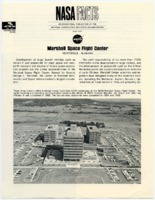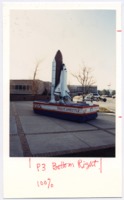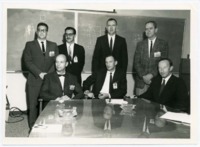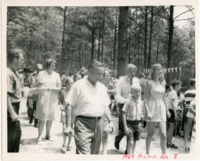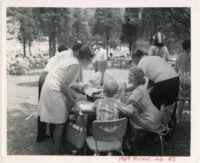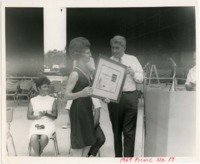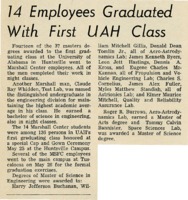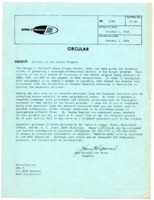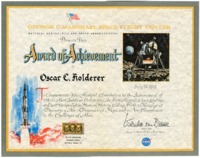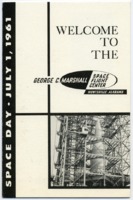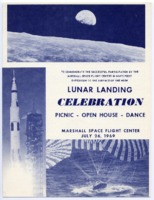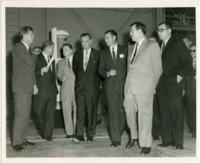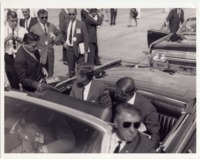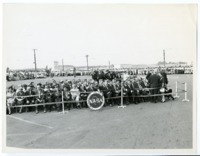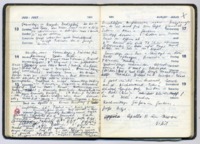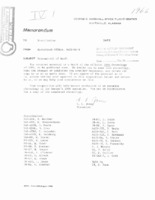
Browse Items (96 total)
Sort by:
-
Abbreviated timeline of the Apollo 11 mission.
The timeline includes a memorandum from Friedjof A. Speer, manager of the Missions Operations Office, to employees of Marshall Space Flight Center. Speer notes that "astronaut Neil Armstrong is scheduled to be the first man to step onto the moon's surface." The timeline outlines the entire mission from liftoff at 8:32 AM on Wednesday, July 16, 1969 to splashdown at 11:49 AM on Thursday, July 24, 1969. -
Transcript of a speech given by Wernher von Braun to the Alabama Legislature.
Von Braun, then the director of Marshall Space Flight Center in Huntsville, Alabama, delivered this speech to the legislature in 1961. In the speech, he emphasizes that Alabama must take advantage of its position in the aerospace industry and create a robust "academic and research environment" in Huntsville to attract businesses that "will give birth to major new industries throughout the state." He exhorts the legislature to fund the newly established University of Alabama Research Institute (now part of the University of Alabama in Huntsville), arguing that "the Institute will not only be self-sustaining, but will enrich the State both financially and culturally." The legislature later approved von Braun's request of $3 million for the Research Institute, enabling the purchase of 200 acres of land for the campus and the construction of the Institute in 1964. The speech includes copies of slides von Braun used during his presentation, including diagrams of Saturn and Nova rockets as well as a mockup of a Saturn rocket on the lawn of the state capitol in Montgomery. -
"SkyLab: An Oral History of America's First Space Station."
This video was released in conjunction with Skylab's 30th anniversary in 2003. It contains video footage from the Skylab program as well as interviews with those associated with the program.Tags Oral History -
Transplanted Rocket Pioneers.
The information in this dataset is reproduced from Charles Lundquist's 2014 monograph Transplanted Rocket Pioneers. The information includes biographical and professional information that he compiled to produce the book. Each individual represented in the dataset also has a vertical file in the Lundquist Collection at UAH.
Transplanted Rocket Pioneers is a recognition of the early members of the von Braun rocket team, many of whom were key players in the successful moon landing. Many historians conclude that the lunar missions of the Apollo Program could not have been possible without the leadership and experience provided by a corps of engineers, scientists and managers transplanted from Europe to the Unites States after World War II. This fact motivated Dr. Lundquist to deposit this work in the Archives of the Library at the University of Alabama in Huntsville by assembling a file on each of the individuals who came from Europe to participate in the rocketry activities in Huntsville, or, in a few cases, individuals who had other ties to Huntsville.
This dataset includes a standard one-page summary sheet for each subject. Although most sheets are relatively complete, some data are still missing.
The first two lines on each page records fundamental identification information:
Family name Date of birth Place of birth Given names Date of death Place of death
The next standard entry is a statement of the extent of the Archives Holdings, either i) A primary collection of documents housed in one or more banker boxes, usually a separate individual collection ii) A secondary collection in a standard archive box, or iii) a file folder. Next, if there is an oral or video history for the individual, this fact is noted. A statement about the highest education levels of the individual follows. The next five entries, in chronological order, record whether the individual participated in activities at five sites:
1. Raketenflugplatz-Kummersdorf: Individuals engaged in the activities at these sites of early rocket development experiments sponsored first by VfR and subsequently by the German Army.
2. Peenemünde: Included here are individuals who participated in Peenemünde programs under several auspices, including as Army civilian employees, as members of the German military, as contractor employees on site or visiting as needed, and as university employees collaborating as required.
3. Fort Bliss: Individuals who were brought to Fort Bliss from 1945 to 1950.
4. GMDD-ABMA: Individuals who came to Huntsville, Alabama to work for the US Army rocket programs in the decade 1950 to 1960.
5th MSFC: Individuals who were employed by the NASA Marshall Space Flight Center in the 1960s.
Some people had various relationships with UAH and that is so noted. Additionally, a statement of immigration details is noted if pertinent. Finally, a great variety of incidental information is included under Incidental Remarks.
UAH Special Collections welcomes additions of biographical materials to the vertical file in the Charles Lundquist Collection. Please note that the work is that of Dr. Lundquist and may contain errors or omissions which are solely the product of his work on the project, as noted in the introduction of the work.: " Finally, it is pertinent to note that any document containing large files will surely have some mistakes or omission. Any errors are the responsibility of the author alone." As was the wish of Dr. Lundquist, we will strive to make factual corrections to the online copy when necessary.
-
Dr. Charles Lundquist (Space History Interviews)
Interview by David Christensen on February 10, 2005Tags Oral History -
William A. Schulze and Hans Palaoro at Marshall Space Flight Center.
The bulletin board behind Schulze reads "Vehicle Engineering Branch." Palaoro was the head of the Vehicle Systems Engineering Branch of the Structures and Mechanics Division at Marshall Space Flight Center. -
NASA Facts leaflet on Marshall Space Flight Center.
The leaflet describes Marshall's role in developing launch vehicles for the space program, its collaboration with NASA facilities in Mississippi and Louisiana, and its research and development operations. Includes a map. -
Space Shuttle Atlantis float on campus at UAH.
The float was made by Marshall Space Flight Center. Von Braun Research Hall can be seen in the background. The photo likely dates from the 1980s or early 1990s, when the NASA worm logo was still in use, as seen on the sides of the float. -
The Apollo Lunar Surface Drill team at Marshall Space Flight Center.
John Bensko, Jr. is seated in the center of the front row. -
Wernher von Braun with daughter Margrit and son Peter in the crowd at the 1969 MSFC employee picnic.
MSFC Director of Administration and Technical Services David H. Newby is shown in the foreground. -
Wernher von Braun presents an Award of Achievement to Jean Drake at the 1969 MSFC employee picnic.
Drake worked in the Safety Office. Lois Smith is shown seated at left. -
"14 Employees Graduated With First UAH Class."
Clipping from the Marshall Star, May 29, 1968, vol. 8, no. 36. -
Circular announcing MSFC's involvement with the documentation of the Saturn program at the UAH Research Institute.
The documentation noted in the circular is available at UAH Archives and Special Collections in the Saturn V Collection. -
Marshall Space Flight Center Space Day 1961 program.
The program includes "Marshall Center Highlights" from the Center's first year, a message from director Wernher von Braun, a photograph of the Space Queen and Princesses, and a guide to the Center's buildings. -
Marshall Space Flight Center "Lunar Landing Celebration" program.
The celebration included an employee picnic, a dance, and an open house. -
President John F. Kennedy visits Marshall Space Flight Center.
Shown in the photograph, left to right: President John F. Kennedy, Robert C. Seamans, Wernher von Braun, James E. Webb, Vice President Lyndon B. Johnson, Robert S. McNamara, Jerome D. Wiesner, and Harold Brown. -
President John F. Kennedy being interviewed by a reporter while MSFC director Wernher von Braun looks on.
Kennedy visited Huntsville for a second time on Armed Forces Day 1963. His first visit occurred on September 11, 1962. -
NASA personnel wait to greet President John F. Kennedy during his second visit to Huntsville.
Kennedy visited Huntsville on Armed Forces Day 1963. He first visited the area on September 11, 1962. -
Crowds and television cameras wait for President John F. Kennedy during his second visit to Huntsville.
Kennedy visited Huntsville on Armed Forces Day 1963. He first visited the area on September 11, 1962. -
Excerpt from the journal of Irmgard Stuhlinger.
Stuhlinger attended the launch of Apollo 11 with her husband Ernst Stuhlinger, then the Associate Director for Science at Marshall Space Flight Center. In the entries, she describes her reaction to the launch and the successful lunar landing and makes note of the celebrations she and her family attended in Huntsville. She also records her daily activities, including socializing with neighbors and shopping with her children. A translation is included. -
1966 Chronology of Marshall Space Flight Center.
This draft copy of the chronology includes a memorandum from Marshall Historian L. L. Jones of the Historical Office. -
Skylab.
Wernher von Braun conversing with multiple people on the management of Saturn/Apollo, Skylab, and Shuttle programs. Both sides. -
M. Urlaub - center.
Interview with Matt Urlaub by Wernher von Braun and others around the Apollo program development and difficulties in its development. One side only. -
Interview with Dieter Grau.
Dieter Grau interviewed on failure analysis and management of Saturn program. Both sides of tape.Tags Oral History -
Interviews with Shields and Davenport (Rocketdyne?).
Interview with Davenport (0-23:44 S1) and Shields (23:44 S1 - end S2). Topics covered include the reliability of the F1 engine, Skylab, and electronic manufacturing.Tags Oral History -
Interviews with Sawyer and Kudebeh (Rocketdyne?).
Interviews with Sawyer (0 - 16:58 S1) and Kudebeh (16:58 S1 - end S2) on weight penalties, schedule/performance bonuses, and project management.Tags Oral History -
Interviews with Weidner and Neubert.
Side 1 is an interview with Weidner and Neubert on the testing of Saturn and the different design philosophies of various NASA groups.Tags Oral History -
Interview with Bauer.
Interview on the developments on Thor applied to the Saturn Program, structures, Welding, Machining of Part, and Insulation of the rocket. Both sides of tape.Tags Oral History -
Interview with Ed Mims.
Interview on the fuels involved in the Saturn as well as the transport and management of these fuels. Both sides of tape.Tags Oral History -
Interview with Schwartz (chief engineer?).
Interview on the development of Saturn engine design and control, as well as life at the Mississippi engine test site. Both sides of the tape.Tags Oral History -
Interview with Newell.
Interview on the Development of Saturn and the general design and management philospohy of NASA. One side of tape only.Tags Oral History -
Interview with H. Paul.
Interview with German engineer on engine design, propellants, thermodynamics, and design barriers and overcoming them. Both sides of tape.Tags Oral History -
Interviews with Fontaine and Attinello, Davenport, Rocketdyne.
Interview with Rocketdyne engineers on rocket engine design and stability. Both sides of tape.Tags Oral History -
Interview with G.A. Phelps (Seal Beach?).
Interview on Materials Management, Configuration Management, and Changes in Design. Full side of tape.Tags Oral History -
Dr. Adolf Thiel, Jim Shepherd, Bob Lindstrom.
Phone Conversation with Dr. Adolf Thiel about Dr. Wernher von Braun and their time working together at Peenemünde and in the United States. Side 1 begninning to 14:18.Tags Oral History -
Tom Shaver (VB assistant), Sarah Preston.
Interview with Tom Shaver on Wernher von Braun, describing his character, personality, and funny stories from his time as von Braun's assistant. Entirety of side one, side 2 through 45 minute mark.Tags Oral History -
Jim Shepherd.
Interview with Jim Shepherd on memories from Wernher von Braun, including him hunting and working with space camp. Both sides of tape.Tags Oral History -
Dr. William Lucas.
Interview with Dr. William Lucas on Wernher von Braun, comparing and contrasting him to Robert Goddard and setting up the University of Alabama in Huntsville, along with other stories. Both sides of tape.Tags Oral History

